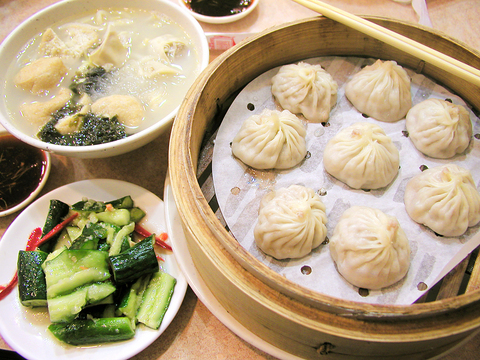The Chinese saying "above are the heavens and on earth are Suzhou and Hangzhou" (上有天堂,下有蘇杭) can be traced to the Tang dynasty when Hangzhou was the largest city in the world and, according to contemporary accounts, had palaces unparalleled in their opulence and filled with the most beautiful women in the whole realm.
It's been many centuries since Hangzhou or Suzhou enjoyed any semblance of the glory of those days, but the cities' storied pasts live on through literature and the rich culinary tradition of Jiang-Zhe cuisine, named for Jiangsu and Zhejiang provinces where the cities are located.
The Su-Hang Snack Shop, on a rather drab section of Roosevelt Road near Guting MRT Station is far from the Jiang-Zhe region and not palatial. It is a small eatery where the simple wonders of this regional food are painstakingly upheld with the emphasis placed on taste over presentation or decor. Now in its third generation, the restaurant is one of those humble hole-in-the-wall institutions serving great food to locals in the know.

PHOTO: MAX WOODWORTH, TAIPEI TIMES
One of the shop's most famous dishes is its tofu and pork vermicelli noodle soup. Its clear broth is light and bursting with flavor while a fistful of assorted greens adds some needed texture and color to this simple dish. The tofu is the highlight here, though, with two large chunks sliced into bite-size pieces that soak up the broth for a delicious combination of flavors.
The other major highlight of the shop is its Su-Hang-style steamed dumplings. There is stiff competition in Taipei for steamed dumplings, with world-rated restaurants Ting-Tai Feng and Kao Ji practically down the road, but Su-Hang holds its own in this category, with a strong, but thin dumpling skin and wonderfully juicy pork inside. The shrimp and pork dumplings are exceptional as well.
People also line up at the store for its hot and sour soup, which can be ordered with noodles. Though not always to everyone's taste, the hot and sour soup here hits a pleasing balance of these two tastes with a hint of sweetness to ease its bite.
Su-Hang Snack Shop is known as much for its above-average food as for its fair prices, which keeps its 24 seats occupied throughout most of the day and certainly at lunch and dinner times. But service is quick and turnover is high, so waiting a short while for a chance to try their food is well worth anyone's time.

June 23 to June 29 After capturing the walled city of Hsinchu on June 22, 1895, the Japanese hoped to quickly push south and seize control of Taiwan’s entire west coast — but their advance was stalled for more than a month. Not only did local Hakka fighters continue to cause them headaches, resistance forces even attempted to retake the city three times. “We had planned to occupy Anping (Tainan) and Takao (Kaohsiung) as soon as possible, but ever since we took Hsinchu, nearby bandits proclaiming to be ‘righteous people’ (義民) have been destroying train tracks and electrical cables, and gathering in villages

Dr. Y. Tony Yang, Associate Dean of Health Policy and Population Science at George Washington University, argued last week in a piece for the Taipei Times about former president Ma Ying-jeou (馬英九) leading a student delegation to the People’s Republic of China (PRC) that, “The real question is not whether Ma’s visit helps or hurts Taiwan — it is why Taiwan lacks a sophisticated, multi-track approach to one of the most complex geopolitical relationships in the world” (“Ma’s Visit, DPP’s Blind Spot,” June 18, page 8). Yang contends that the Democratic Progressive Party (DPP) has a blind spot: “By treating any

This year will go down in the history books. Taiwan faces enormous turmoil and uncertainty in the coming months. Which political parties are in a good position to handle big changes? All of the main parties are beset with challenges. Taking stock, this column examined the Taiwan People’s Party (TPP) (“Huang Kuo-chang’s choking the life out of the TPP,” May 28, page 12), the Democratic Progressive Party (DPP) (“Challenges amid choppy waters for the DPP,” June 14, page 12) and the Chinese Nationalist Party (KMT) (“KMT struggles to seize opportunities as ‘interesting times’ loom,” June 20, page 11). Times like these can

Swooping low over the banks of a Nile River tributary, an aid flight run by retired American military officers released a stream of food-stuffed sacks over a town emptied by fighting in South Sudan, a country wracked by conflict. Last week’s air drop was the latest in a controversial development — private contracting firms led by former US intelligence officers and military veterans delivering aid to some of the world’s deadliest conflict zones, in operations organized with governments that are combatants in the conflicts. The moves are roiling the global aid community, which warns of a more militarized, politicized and profit-seeking trend